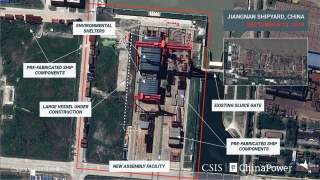Say Cheese! Satellite Photos Reveal China’s New Aircraft Carrier
High-resolution, commercial satellite images of China’s Jiangnan shipyard in September 2019 provided the clearest glimpse yet of the Chinese navy’s third and largest aircraft carrier.
High-resolution, commercial satellite images of China’s Jiangnan shipyard in September 2019 provided the clearest glimpse yet of the Chinese navy’s third and largest aircraft carrier.
Reuters obtained the photos from the Center for Strategic and International Studies in Washington, D.C. In the images, construction of the Type 002 carrier appears to be well underway at the shipyard near Shanghai.
The Type 002 would be the Chinese fleet’s first full-size carrier with catapults for launching heavy aircraft. Beijing’s first flattop, the Type 001 Liaoning, is a refurbished ex-Soviet vessel with a ramp for launching planes instead of catapults. The Chinese-made Type 001A carrier is a copy of the Type 001.
Liaoning, which foreign analysts have described as a training and test vessel, is in service. The Type 001A is mostly complete and could enter service in late 2019. CSIS experts told Reuters that shipyard workers could complete the Type 002’s hull by late 2020.
The shipyard quickly has expanded across what once was abandoned farmland, Reuters reported. "We can see slow but steady progress on the hull, but I think the really surprising thing these images show is the extensive infrastructure buildup that has gone on simultaneously," CSIS analyst Matthew Funaiole told the wire service.
"It is hard to imagine all this is being done for just one ship," he added. "This looks more like a specialised space for carriers and or other larger vessels."
Chinese sources have made no secret of Beijing’s intention eventually to build up a fleet of six carriers, two for each of the Chinese navy’s northern, eastern and southern regional fleets. One vessel in each fleet could deploy while the other underwent maintenance.
Beijing might try to copy the United States’ scheme for deploying carriers. The U.S. fleet plans to deploy six of its 11 carriers within 30 days of a crisis, plus a seventh within 90 days.
In 2018, each of China’s regional fleets possessed between 20 and 30 major surface warships, at least a dozen submarines and a handful of amphibious vessels. Liaoning, which commissioned in 2012, belongs to the northern fleet.
Liaoning displaces 55,000 tons of water. Her powerplant is non-nuclear. Sister vessel Shandong also has a conventional powerplant. The two ships’ ramp layout probably limits their aircraft to a maximum launch weight of 30 tons, a former Chinese navy source revealed.
China's J-15 naval fighter weighs nearly 20 tons empty. Fuel usually accounts for most of the available 10-ton payload, limiting the fighter's normal weapons loadout to just a few small missiles. The U.S. Navy's carriers use steam catapults to launch aircraft weighing as much as 50 tons.
Which is not to say Liaoning and her sister ship aren't useful. "Though Liaoning has substantially less capability than a U.S. Navy carrier, it provides extended air-defense coverage for at-sea task groups and is being used to develop further China’s carrier pilots, deck crews and tactics," the U.S. Defense Department noted in the 2018 edition of its annual report on the Chinese military.
The Type 003, which could displace around 70,000 tons of water, possesses catapults but apparently has conventional propulsion. Wang Yunfei, a retired Chinese navy officer, told Global Times that flattops numbers five and six might feature nuclear propulsion, making them roughly equivalent to the U.S. Navy's own Nimitz- and Ford-class carriers, each of which displaces around 100,000 tons.
Song Zhongping, a military expert and T.V. commentator, told Global Times that China's two ramp-equipped carriers would remain close to Chinese shores, while the bigger, catapult-equipped vessels sail farther into the Pacific and Indian Oceans.
A six-carrier fleet could set back the Chinese government tens of billions of dollars. The U.S. Navy spends $14 billion to build each new Ford-class carrier. A Nimitz costs around $500 million per year to operate.
China's own, smaller flattops surely are somewhat cheaper than that. The Royal Navy's two new carriers Queen Elizabeth and Prince of Wales, which roughly are the same size that the Chinese ships are and also are non-nuclear, cost $5 billion apiece just to build.
China spent around $200 billion on its military in 2018. The United States spent $700 billion. But a dollar goes farther in China, prompting some experts to declare that Washington and Beijing in 2018 actually spent roughly the same amount, adjusting for purchasing power.
David Axe serves as Defense Editor of the National Interest. He is the author of the graphic novels War Fix, War Is Boring and Machete Squad.
Image: Reuters.
Image Description: A satellite image shows parts for an aircraft carrier under construction at Jiangnan Shipyard in Shanghai, China September 18, 2019. Picture taken September 18, 2019. Mandatory credit CSIS/ChinaPower/Airbus 2019/Handout

